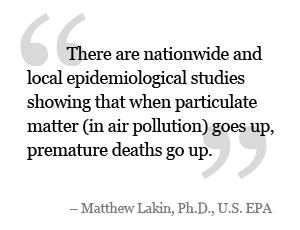Pets and Wood Smoke Pollution
Wood smoke isn’t just bad for human health—it’s bad for animal health as well, as noted in a recent Mercury News article.
Our pets breathe the same air we do, so it should come as no surprise that dogs and cats are similarly vulnerable to the particulate pollution and toxic compounds in wood smoke.
Animals may not be able to complain, but asthma symptoms such as wheezing and coughing can alert owners that their pets are having trouble breathing.
The best way to control these symptoms is to make sure the air in your house is as clean as possible by not burning wood (or smoking) and by living in an area that’s free of wood smoke pollution from neighboring properties.
Sam Harris on the Wood Burning Delusion
A recent piece by Sam Harris, The Fireplace Delusion, eloquently addresses the difficulty of convincing people that burning wood is a harmful practice. Harris, who has a Ph.D. in neuroscience from UCLA, is best known for his books and articles that address issues concerning religion, science, tolerance, and society.
Harris points out that many rational, well-educated people love to burn wood, despite the plethora of studies indicating that wood smoke is harmful to human health.
Indeed, wood burning takes on an almost religious status for such people, who choose to believe that the smoke is harmless, regardless of clear evidence to the contrary.
“The case against burning wood is every bit as clear as the case against smoking cigarettes,” notes Sam Harris in a recent blog post, “Indeed, it is even clearer, because when you light a fire, you needlessly poison the air that everyone around you for miles must breathe.”
Harris declares, “It is time to break the spell and burn gas—or burn nothing at all.”
We at Families for Clean Air agree. Please, get the facts. Don’t burn wood.
Researcher Says Wood Burning Not Sustainable
A fascinating article, “Heating and Air Pollution,” discusses the disproportionate contribution of wood smoke to pollution when wood burning is used as a heat source. The author, Marcelo Mena, is the Director of the Center for Sustainability Research at Universidad Andres Bello and performs research on regional air quality and climate modeling.
The bottom line, Mena notes in a follow-up comment to the article, is that current use of wood burning in many developing countries and in the US is not sustainable because it generates orders of magnitude more particulate pollution than other fuel sources.
Mena notes that in Santiago, Chile, just 8 percent of the population uses wood burning stoves, yet the resulting soot makes up 49 percent of air pollution. This is paralleled by findings in the Bay Area, where the number of people who rely on wood stoves for heat is low, yet wood smoke makes up more than 30 percent of winter time air pollution.
Mena also notes that a stringent ban on wood burning on bad air days in the San Joaquin Valley in California led to a remarkable 44 percent reduction in the number of days when the air quality was unhealthful. “In my years working in air pollution,” Mena stresses, “I’ve never seen a single measure with such effectiveness in reducing pollution.”
What are the ramifications for clean air policies? Mena suggests that in cities, where the wood smoke pollution burden adds to that from vehicular pollution, we should think about outright bans in wood burning.
EPA: Wood Burning “Relic from the Past”
EPA Regional Director Jared Blumenfeld was recently interviewed on San Francisco’s KCBS radio, speaking out about the health and environmental hazards of wood smoke pollution. The segment talks about why all wood burning will eventually be banned.
The piece is only a minute long, but definitely worth a listen:
Wood Smoke Radio Segment
New Year’s Resolution: Cleaner Air in 2012
Every year during the holiday season, people gather around the fireplace to celebrate with family and friends. Unfortunately, fireplaces are also fire hazards with hot embers or ashes leading to nearly 11,600 residential building fires in the U.S. each year.
While many are aware of the fire danger posed by fireplaces, the hazards posed by wood smoke are just as real, but far less publicized. The EPA notes that fine particles from wood smoke have serious adverse health effects.
Fireplaces and wood stoves are the single largest source of fine particulate matter (PM2.5) in many areas in the winter, including the San Francisco Bay Area. Study after study shows that PM2.5 worsens asthma, increases heart attacks, damages lungs, and even leads to death.
This New Year’s Eve, why not skip the fire and the toxic wood smoke?
Instead, raise your glass to good health and clean air in the coming year.
Happy New Year from Families for Clean Air.





